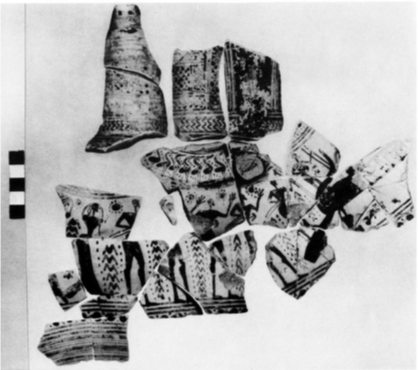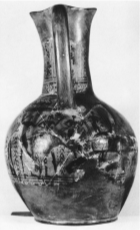Fragmentary ship to the right, with the stern section preserved. The depiction is unusual in that there is no curve or thick section to denote the ship's keel. The hull instead consists only of the horizontal ladder motif, comprised of two thin horizontal lines joined by five vertical strokes, which should be interpreted as an open rowers' gallery intersected by vertical stanchions. There are three oars in the first three rowers' rooms. The first one has a spade-shaped blade preserved, while the third one shows that these start from the upper horizontal line which represents the gunwale and deck level on which the seated figure is placed. The fourth and fifth spaces are occupied by seated figures, with the one on the right being better preserved with distinct head, shoulders and torso. The sternpost ends in a horn that slopes forward then upward. The solid rectangular appendage used by one of the warriors to climb aboard the ship has been interpreted as a gang-plank. The quarter rudder is painted below the stern in a near vertical position, with a spade-shaped blade.
Warriors boarding a galley
A159
Late Geometric IIa (c. 725 B.C.)
Attica
H: c. 25 cm; body max. circumference: 51 cm; frieze H: 7.8 cm
trefoil mouthed oenochoe by the Birdseed workshop. Fine brown clay, brown-black to reddish paint
Hobart no. 31, John Elliott Classics Museum
Basch 1987: no. 371; Hood 1967: 82-87, pl. 31, fig. 1a-c, pl. 32, fig. 2,3; Morrison-Williams 1968: 36, Geom. 39, pl. 7b; Tzahou-Alexandri 1990: 342
Scene of departing warriors boarding a ship. A procession of six figures facing to the right, comprised of two women followed by four warriors. The women are identified by strands of wavy hair and long skirts painted solid, with their hands to their heads in a gesture of lamentation and mourning. The warriors are naked, with their left hand raised, while the right holds on to a sword at waist level. The second stroke which is not carried across the body perhaps represents a dagger. Two additional warriors are painted on a smaller scale in the process of boarding the ship. In addition to swords, these latter figures hold a pair of spears in their left hands. Finally, there are three more figures on the ship itself - one sitting with his feet dangling over the open rowers' galleries, and two more sitting on rowing benches below. There is a fish located below the hull near the quarter rudder. While not indisputable, it is plausible to interpret the depiction as a single scene. This is strengthened by the two warriors in different stages of boarding the ship, which provide a transition between the figures on land and those already aboard the vessel. Furthermore, all of the figures (including the women) face towards the ship, thus directing the viewer gaze in its direction all the while giving the impression that the figures on land are involved in the same event.
The depiction is highly unusual in the rendition of its hull. If the identification of a fish below is correct, the most plausible explanation as to why the sternpost does not curve gradually towards the keel but instead transitions abruptly into a straight line is that the artist meant to illustrate only the freeboard above the waterline. Another detail possibly in favour of this interpretation is that the figures appearing in the rower's galley have only their torsos shown, their legs thus presumably extending further below, in the section of the hull below the waterline. The plank at the stern on which one of the warriors is standing could have been easily misinterpreted as the quarter rudder, if not for the placement of another, very differently shaped quarter rudder directly below the stern. If the interpretation of the ship being afloat is correct, then the gang-plank makes perfect sense. The seated figure confirms two important points. First, that there is a deck above the rower's gallery, and second, that this gallery was open, as we can see his feet dangling in the reserved space. The beginning of the oars from the upper horizontal line is problematic. It is clear furthermore that there were no oars in the fifth and sixth rowers' rooms where the seated figures are, since for the left-hand room the fragment is sufficiently preserved to confirm that no oar sloped down from the area.
The artist made numerous accommodations, including several to prevent overlap. These include: 1) the varying scales in which the figures are drawn; 2) the displacement of the quarter rudder in a near vertical position below the stern to provide space for the gang-plank; 3) the lengthening of the second rowers' gallery to provide sufficient space for the legs of the sitting figure and the resultant squeezing of the third gallery; and 4) the slight curving of the top of the second oar to avoid overlap with the right leg of the seated figure. It could be surmised that the omission of the oars in the fifth and sixth galleries was also a result of the seated figures filling those spaces.
Basch, L. 1987. Le musée imaginaire de la marine antique. Athens: Institut Hellénique pour la preservation de la tradition nautique.
Hood, R.G. 1967. “A Geometric oenochoe with ship scene from Hobart,” AJA 71: 82-87.
Morrison, J.S. and R.T. Williams. 1968. Greek Oared Ships: 900-322 B.C. Cambridge: Cambridge University Press.
Tzahou-Alexandri, O. 1990. “Contribution to the knowledge of 8th century B.C. Ship Representations,” in H.E. Tzalas (ed.) Tropis II: 2nd International Symposium on Ship Construction in Antiquity. Delphi 1987 (Hellenic Institute for the Preservation of Nautical Tradition). Athens: Hellenic Institute for the Preservation of Nautical Tradition, pp. 333-61.








